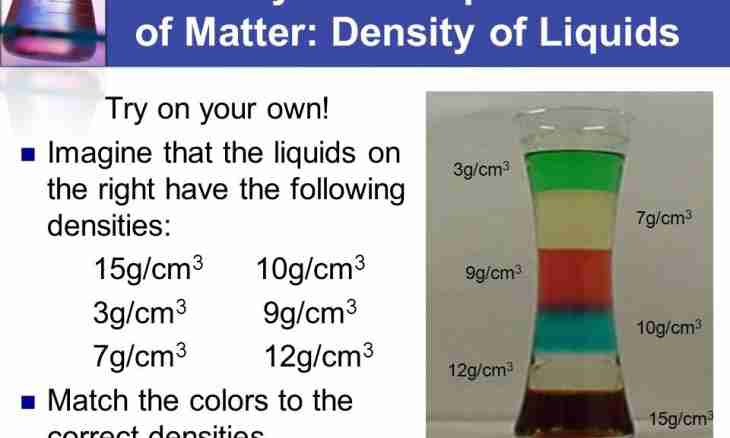Density of liquid is a physical quantity which shows the mass of this liquid in unit of volume. Density of liquid can be measured by both an indirect method, and direct measurements by means of special adaptation.
It is required to you
- volumetric glass or graduated cylinder, scales, ruler, areometer.
Instruction
1. So, you have liquid which density you are going to determine. Take an empty volumetric glass or a graduated cylinder, put on scales and determine the mass of an empty vessel without liquid. Designate it by m1, for example. Further pour liquid which density you want to measure in this vessel. Pour liquid to such level that it was easy to determine its volume (on small volumetric glasses the volume scale in milliliters is put).
2. After you defined and wrote down the volume of liquid (V), put this capacity on scales again, just now it will be with liquid. Write down new weight and designate it by m2. Knowing the mass of an empty vessel of m1 and a full vessel of m2, determine the mass of liquid m by a formula: m = m2 – m1. Now it is possible to pass directly to determination of density ro: ro = m/V, where m and V – the weight and volume of liquid found above.
3. Remember that the volume of liquid is measured, as a rule, in kilograms on cubic meter or in grams on centimeter cubic. Therefore you translate the measured sizes to one or second standard system of units of measure. For example: 1 milliliter = 1 cubic santimetr1000 liters = 1 cubic metr1 kilogram = 1000 grams
4. If a vessel with liquid rather big, but you know the mass of an empty vessel of m1 and mass of the filled m2 vessel, then it is possible to arrive as follows. At first find the mass of liquid in a vessel on formula m = m2 – m1. Then by means of a ruler or a roulette measure the geometrical sizes of a vessel: for rectangular vessels measure height, width and length, and for cylindrical – diameter and height. For finding of volume of a rectangular vessel use a formula: V = a * b * h where an is width, b is length, h is vessel height.
5. For finding of volume of a cylindrical vessel take a formula: V = (pi * d * d * h) / 4, where pi – Pi's number equal 3.14, d – diameter of a vessel, h – its height (liquid level height). After finding of volume find liquid density, as well as in the previous case, on a formula ro = m/V.
6. The problem of determination of density much more becomes simpler if you have an areometer. This device is a glass flask with a float and a scale. Just lower it in liquid so that it did not concern a bottom, and on a scale in the top part of the areometer look at value of density of liquid. Often motorists for determination of density of electrolyte in the accumulator use the areometer.

